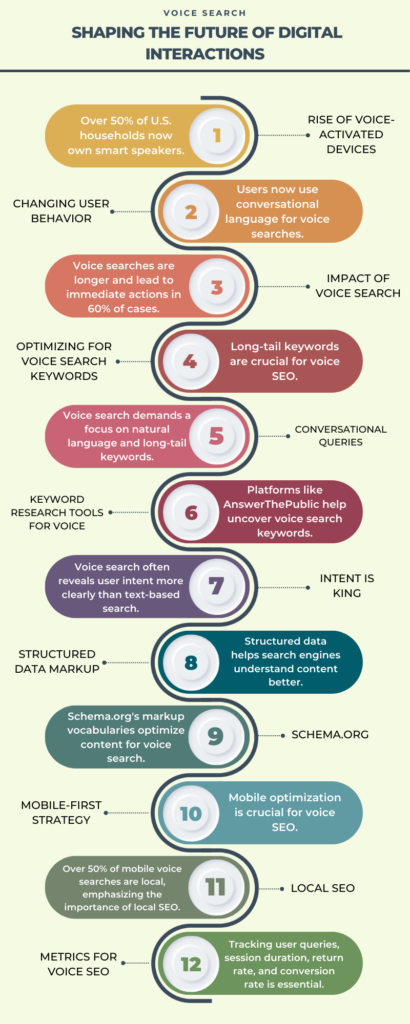With the dawn of a new age in technology, search habits are evolving. Remember when typing out a query was the norm? Fast forward to 2023, and voice search is not just an emerging trend – it’s the norm. But here’s the million-dollar question: Is your digital marketing strategy attuned to this change?
Contrary to the belief of some, voice search isn’t a fleeting trend. It’s a paradigm shift in the way users seek information. As voice-activated devices become household staples, businesses must rethink their SEO strategies. Let’s delve into the world of voice SEO and uncover the strategies that make a difference.
Talking to the Future: How Voice Search is Shaping Digital Interactions
In a world dominated by Siri, Alexa, and Google Assistant, voice search is no longer just a sci-fi fantasy. It’s a reality that’s changing how users interact with devices and search for information.


The Rise of Voice-Activated Devices
From smartphones to smart speakers, voice-activated devices are becoming ubiquitous. A recent study found that more than 50% of households in the U.S. now own a smart speaker.
Changing User Behavior
With these devices, searching has become more conversational. Users no longer type “weather NYC”; they ask, “What’s the weather like in New York today?” This shift in phrasing and tone has significant implications for SEO strategies.
The Impact
Data suggests that voice searches tend to be longer and more specific than text-based ones. Moreover, a staggering 60% of voice searches result in immediate action – be it a purchase, a website visit, or another form of engagement.


Remember when Domino’s Pizza introduced voice ordering? It was revolutionary! Customers simply had to speak to place their orders, making the process faster and more intuitive. It’s a testament to how voice search can redefine customer interactions.
Optimizing for Voice Search Keywords
While traditional SEO heavily relies on short, specific keywords, voice search turns the tables. With voice queries being more conversational, long-tail keywords become the stars of the show.


The Rise of Conversational Queries
Voice searches tend to be more natural. Instead of “best coffee NYC,” users might ask, “Where can I get the best coffee in New York?” This shift demands a renewed focus on long-tail keywords and natural phrasing.
Keyword Research Tools for Voice
Platforms like AnswerThePublic or Google’s “People also ask” section can provide insights into the kind of questions people pose to voice assistants. These platforms help businesses uncover long-tail keywords that resonate with voice search users.
Intent is King
Voice search often reveals a user’s intent more clearly than text-based search. For instance, “How to tie a tie?” indicates a need for instructional content. Recognizing and catering to this intent is paramount for voice SEO.
Consider Best Buy, a leading electronics retailer. Recognizing the shift towards voice search, they revamped their keyword research strategy. Instead of focusing solely on short keywords like “4K TV,” they incorporated longer, more conversational phrases like “What’s the best 4K TV for gaming?” The result? A significant boost in organic traffic and an enhanced user experience.
Structured Data Markup and Schema.org
Structured data acts like a translator between your content and search engines. While your content speaks to the audience, structured data ensures search engines grasp the essence, context, and relevance of that content. And when it comes to voice search, structured data is the unsung hero.


What is Structured Data?
In layman’s terms, it’s a standardized format to provide information about a webpage. It helps search engines better understand the content, context, and hierarchy.
Schema.org – The Gold Standard
Founded by Google, Microsoft, Yahoo, and Yandex, Schema.org provides a shared collection of schemas, aka markup vocabularies. Implementing these can optimize how your content appears in search results, especially for voice search.
Voice Search and Structured Data
Voice search results often pull from rich snippets, which are enhanced search results. By using structured data, you can increase the chances of your content being featured.
Imagine searching for a chocolate chip cookie recipe. With structured data, a website can highlight specific details like cooking time, calorie count, and ratings. So when someone asks their voice assistant for a “quick chocolate chip cookie recipe,” the one with a 15-minute cooking time (thanks to structured data) might be read aloud.
Mobile-First, Voice-First: The Dual Strategy
With the majority of voice searches conducted on mobile devices, there’s an inextricable link between mobile optimization and voice SEO.


The Mobile-Voice Connection
A whopping 60% of mobile users have tried voice search at least once in the past year. Given the convenience of voice commands on mobile devices, this trend is poised to grow.
Page Load Speed
Mobile users are impatient. If a page takes more than a few seconds to load, they’re likely to bounce. And with voice searches demanding quick answers, page speed becomes crucial. Tools like Google’s PageSpeed Insights can provide actionable feedback.
Design and Layout
A mobile-optimized design isn’t just about fitting content on a smaller screen. It’s about intuitiveness, easy navigation, and ensuring users find what they’re looking for without pinching and zooming.
Local Searches
Over 50% of mobile voice searches are local. This means optimizing for local SEO, which we’ll delve into in the next chapter, is vital. Think “near me” searches and local business listings.
Consider a user asking their voice assistant for “the best digital marketing agency near me.” If your digital marketing firm has optimized its mobile site for local SEO, integrated structured data, and ensured quick load times, your agency might just be the top recommendation!
Local SEO and Voice Search
As the digital world becomes increasingly intertwined with our everyday lives, consumers are seeking immediate, localized solutions to their queries. And voice search, with its convenience and rapid-fire results, is spearheading this shift.


The Rise of Local Voice Search
Data reveals that voice-related searches are 3 times more likely to be local. When users speak to their devices, they’re often on the go, seeking nearby services or establishments.
Business Listings and Reviews
Google My Business is the bedrock of local SEO. Ensuring that your business is listed, with updated information and positive reviews, can significantly enhance your visibility in voice searches.
The Importance of “Near Me”
Integrating “near me” within your SEO strategy can elevate your chances of being the top pick in local voice search results.
Hyperlocal Optimization
Going beyond broad local terms and incorporating hyperlocal information (specific neighbourhoods, landmarks) can fine-tune your local voice search optimization.
Imagine someone driving through Chicago, asking their voice assistant, “Where’s the best coffee shop near the Willis Tower?” If a coffee shop in the vicinity has optimized its content for both “Chicago” and “Willis Tower,” it’s likely to be the top recommendation.
Speak Their Language: Aligning with User Expectations
Voice searches are distinctively conversational. People speak to voice assistants as they would to another human. Hence, understanding user intent becomes paramount.
Question Phrases and Long-Tail Keywords
Voice searches often start with Who, What, Where, Why, or How. Tailoring content to answer these queries can increase visibility.
Featured Snippets and Voice Search
Google’s voice search often pulls from featured snippets. Creating content that directly answers user questions can increase your chances of securing these coveted positions.
Content That Converses
Voice search optimization isn’t just about keywords; it’s about natural language. Crafting content that mirrors spoken language can resonate better with voice algorithms.
Let’s say someone asks, “How can a digital marketing agency boost my online presence?” If a digital marketing firm has a blog post titled “How a Digital Marketing Agency Can Elevate Your Online Brand,” it’s poised to be the voice assistant’s answer.
Listen to Understand: Metrics that Matter in Voice SEO
The evolving nature of voice search necessitates a fresh approach to analytics. Tracking and understanding specific metrics can provide a roadmap for refining your voice SEO strategy.


User Queries
What are users asking voice assistants? Monitoring the exact phrasing of voice searches can provide insights into user intent and shape content strategies.
Session Duration
A long session after a voice query might indicate the user’s engagement with your content. On the other hand, a short session might signify that the user didn’t find the answer they were seeking.
Return Rate
How often are users returning after initiating a voice search query? A high return rate can denote content relevance and effectiveness.
Conversion Rate
Especially vital for businesses, understanding how many voice searches lead to tangible actions (like making a purchase) can guide optimization efforts.
Imagine a local bakery noticing a surge in voice queries like “best chocolate chip cookies near me” every weekend. They could tailor their weekend specials or advertising to cater to this demand.
Conversing with the Future: Siri, Alexa, and Beyond


Artificial Intelligence powers the voice assistants we’ve come to rely on. These AI-driven systems constantly learn from user interactions, evolving to provide better and more relevant responses.
Understanding Different Platforms
Each voice assistant has its unique algorithm and data processing method. Whether it’s Google’s Assistant, Apple’s Siri, or Amazon’s Alexa, optimizing for each platform is crucial.
AI’s Continuous Learning
The more users interact with voice assistants, the smarter they get. This continuous learning process is reshaping how we approach SEO.
Interactive Content
Voice assistants are moving beyond mere search results. They’re integrating with apps, controlling smart home systems, and even making purchases. Ensuring your content is interactive can enhance user experience.
A user asking their Google Assistant about “keyword research services” might not only get a list of digital marketing agencies but also an option to book a consultation directly through the search.
Echoes of Uncertainty: Navigating Voice SEO Challenges
The path of innovation is seldom without bumps. As marketers and businesses ride the voice SEO wave, they face unique challenges:
Privacy Concerns
With devices always “listening,” user data privacy becomes a paramount concern. Ensuring transparency and adhering to data protection regulations is non-negotiable.
Algorithm Updates
Voice search algorithms are evolving rapidly. Staying updated with these changes and adapting strategies accordingly is vital for sustained success.
Monetization Dilemmas
As voice search grows, so does the question of monetizing it. For instance, how can ads be integrated without disrupting the user experience?
Remember the uproar when users found out their voice-activated devices might be recording personal conversations? Such concerns can impact user trust and adoption rates.
Voice 2.0: Emerging Trends in Voice Search
Voice search isn’t static; it’s dynamic and ever-evolving. Here’s a glimpse into the future:
Voice Commerce
Users will not just search but will also make purchases using voice commands. “Order my usual pizza,” could soon become a standard voice command.
Multimodal Voice Search
Combining voice with screen-based feedback offers a richer user experience. Imagine asking your device about a product and seeing its image or video as a response.
Integration Across Devices
Voice search will transcend smartphones and smart speakers. Integration with smart TVs, cars, and even refrigerators is on the horizon.
Brands are already developing voice-activated experiences. For instance, asking Alexa about a digital marketing firm might soon play a brief promotional audio snippet from a top-ranked agency.
Tracking and Analytics Mastery
As with any digital strategy, tracking and analyzing performance is the keystone of voice SEO.
Voice Search Query Analysis
By understanding the exact phrases and questions users pose, businesses can refine their content and offerings.
Position Zero Tracking
Voice search often pulls from the featured snippet or “position zero” on search results. Tracking when and how often you occupy this coveted spot can offer insights.
Device Breakdown
Analyzing which devices (smartphones, smart speakers, etc.) are most frequently used for voice search can guide optimization efforts.
Consider a company that offers link building services. By analyzing voice search queries, they realize many users ask, “How does link building benefit SEO?” This insight could prompt the creation of content addressing this specific question.
Conclusion: Capturing the Voice of the Future
The digital landscape is in a state of constant flux, with voice search representing one of the most transformative shifts in recent history. From our explorations, it’s abundantly clear that the era of voice SEO isn’t just looming on the horizon; it’s already here. The change isn’t simply a matter of technology; it’s a fundamental shift in the way people search, interact, and engage with the digital realm.
While textual searches often reflect a user’s surface-level intent, voice searches delve deeper. They’re more personal, conversational, and revealing. This presents both an opportunity and a challenge. The opportunity? To engage users in more meaningful, direct ways. The challenge? To decipher and cater to these nuanced intents efficiently.
Businesses, especially those with a keen focus on digital marketing services, need to approach voice SEO with a dual mindset. On one hand, there’s the need to stay updated with the latest technological advancements, be it AI algorithms or voice recognition software. On the other, there’s an imperative to maintain a deep connection with human users, understanding their desires, questions, and needs.
Interested in fine-tuning your voice SEO strategies? Reach out to NeuroImpakt, a leading digital marketing agency, for a personalized consultation. Let’s craft a voice strategy that resonates.
